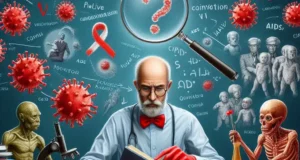If the early years of the AIDS crisis were like a city choked in fog—uncertainty, fear, and silence—then ACT UP was the thunderstorm that cracked the sky open. With fiery voices, bold action, and fearless visibility, ACT UP (AIDS Coalition to Unleash Power) emerged not as scientists or politicians, but as activists who refused to let the world ignore the suffering caused by AIDS.’

In the 1980s, as the world kept whispering, “AIDS, where did it come from?”, There was stigma. There was fear. But more dangerously, there was inaction. Governments stalled. Pharmaceutical companies hesitated. Public health systems were slow. And behind this delay were real lives—people losing friends, lovers, children, and time.
It wasn’t a typical nonprofit with formal suits and quiet meetings. It was a movement—a street-level rebellion made up of people living with AIDS, their allies, artists, students, and those who had had enough. They shouted, they marched, they protested, and they refused to be invisible.
To understand ACT UP, imagine a fire alarm being pulled in a burning building where everyone is pretending nothing’s wrong. ACT UP was that alarm. And its signal was clear: People with AIDS deserved treatment, dignity, and attention—now.
But their activism wasn’t just noise—it was strategy. They used dramatic, unforgettable actions to spark media attention and public outrage. From disrupting Wall Street to die-ins at St. Patrick’s Cathedral to covering the FDA with protest signs, ACT UP forced the world to stop asking only “AIDS, where did it come from?” and start asking “Why aren’t we doing more?”
Their efforts pressured the FDA to fast-track the approval of life-saving drugs. They demanded (and achieved) changes in clinical trial policies to include women, minorities, and people with low incomes. They confronted political leaders who ignored the crisis and educated the public about prevention and compassion. Through zines, posters, public performances, and televised interviews, ACT UP became the megaphone for those silenced by stigma.
And yet, ACT UP didn’t focus on origin alone. While scientists worked to trace HIV from chimpanzees in Central Africa—offering answers to the question “AIDS, where did it come from?”—ACT UP focused on the present: “What do we do now that it’s here?” Their answer was simple but revolutionary: Fight back. Demand justice. Refuse to die quietly.

Over time, ACT UP chapters spread across cities and countries, uniting people from different backgrounds into one of the most effective grassroots health movements in modern history. Their work directly influenced how HIV research was funded, how patients were treated, and how society viewed people living with AIDS.
ACT UP’s legacy isn’t measured in documents or laws—it’s measured in lives saved, treatments developed, and silences broken. Thanks to their efforts, the world moved faster to create antiretroviral therapies, promote safe sex education, and remove the shame surrounding HIV.
So when history asks, “AIDS, where did it come from?”, let’s also ask, “Who stood up when no one else did?” The answer is ACT UP—warriors not of war, but of awareness. They didn’t just change policy. They changed culture.
They turned mourning into marching. Grief into grit. And fear into fuel.




